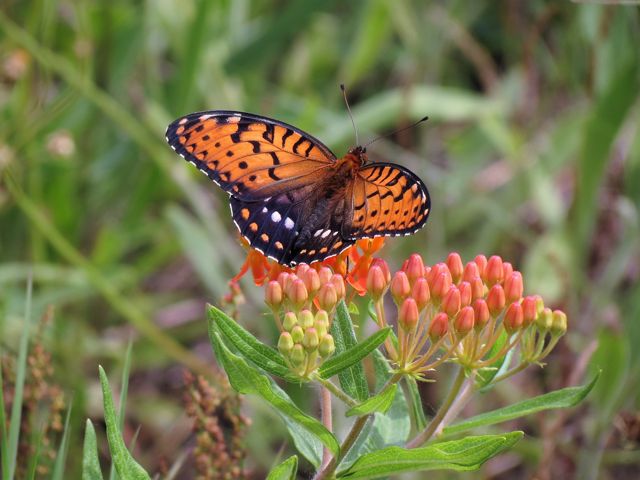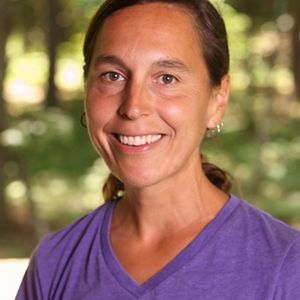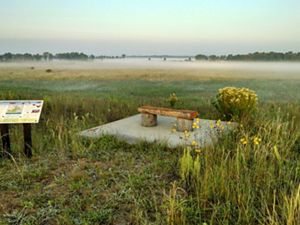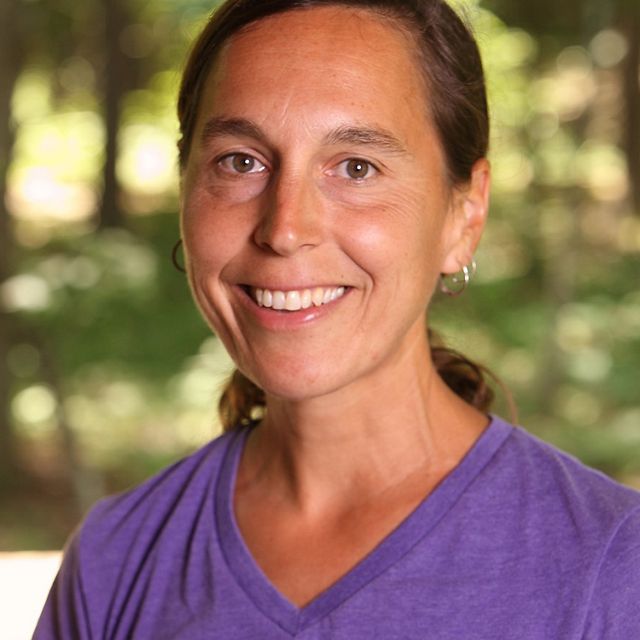Jumping for Joy: Finding a Paradise Jumping Spider
When you plant a garden, sometimes you get surprises—like the tomatillos and dill that are unexpectedly growing in my garden from last year’s seed. And sometimes you get other surprises, too—a goldfinch that flies in or perhaps the caterpillar of a swallowtail butterfly. The same is true with prairie plantings.
When we began retiring our Kankakee Sands agricultural fields 20 years ago in order to restore the prairie landscape, we spread thousands of pounds of seed of hundreds of different types of native plants. We got some expected results—like a lot of big and little bluestem grasses. We got some exciting surprises, too—a rare three awn grass and nodding ladies tress orchids.
And we got frogs—lots and lots of frogs—as well as grassland birds, butterflies, dragonflies. So many animal and insect species moved in because of the prairie that was planted.
Over the years, we’ve documented thousands of plant and animal species at Kankakee Sands, but we haven’t inventoried everything. Not even close!
And that, my friends, is the beauty of the BioBlitz. On June 3, TNC partnered with the Indiana Academy of Science (IAS) to host this year’s BioBlitz at Kankakee Sands. More than 100 scientists, experts and nature enthusiasts from around the state came to Kankakee Sands for the 24-hour event with the goal of inventorying as many species of living creatures as possible.
Participants explored Kankakee Sands, surveying for ants, aquatic macroinvertebrates, bees, beetles, birds, fish, freshwater mussels, fungi, reptiles, amphibians, moths, butterflies, mammals, singing insects, snail-killing flies, spiders and vascular plants. The findings are a snapshot of the diversity of species at Kankakee Sands and a peek into the health of our prairies.
Within several hours of surveying, the BioBlitz spider team stumbled upon a striking jumping spider that caught their attention. Team member Casey Venable was the first to notice the spider, and she quickly called Rick Malad over to identify it.
Finding the Jumping Spider






Rick Malad shares,
We found the Habronattus decorus during our first stop of the day at Unit H, so we were just getting started. I do recall talking the day before with our team leader, Kevin Wiener, about the potential for finding Habronattus spiders at Kankakee Sands. It’s good habitat for them, and I was extremely excited when Casey found one right out of the gate.
I knew immediately that it wasn’t a species I had seen before—a lifer for me—and it is a very striking spider. I was pretty giddy about it, so I set to identifying it while I was still kneeling on the ground. Fortunately, it’s a distinctive species, so identification was easy. I checked several resources when we got back to the car and realized it likely hadn’t been reported in Indiana yet.
As jumping spiders go, this guy was pretty cooperative in front of the camera. He was doing something which you’ll see in jumping spiders every once in a while: he wouldn’t stay off of my hands. Most spiders flee from human skin in a hurry, but some individuals, for some reason, seem unbothered by it. It’s an endearing quality but does make achieving a natural setting in a photograph a bit of a challenge.
This particular jumping spider, a paradise jumping spider, is fairly widespread and has been found across much of the United States and Canada but lacks documentation from much of the Midwest. Jumping spiders don’t make webs to capture prey. Instead, they rely on their excellent vision, quick movements and strong forelegs.
Of her discovery, Casey shares,
To me what’s also interesting to note is that this species has been documented in surrounding states but somehow slipped through the cracks of Indiana records. In fact, Dr. Marc Milne, professor of biology at the University of Indianapolis, has added hundreds of spiders to Indiana’s list in just the last decade. To me it’s amazing these discoveries are still being made in 2023.
As Casey said, species do go unnoticed, especially in large spaces like the 8,000 acres at Kankakee Sands, not to mention the even larger 20,000 acres of natural area of Newton County.
The full results of this year’s BioBlitz will be summarized by this fall and will be published in the Indiana Academy of Science Journal. Learn more about the BioBlitz.
This summer, be sure to visit Kankakee Sands and help us discover all the amazing things that are utilizing the natural spaces, places, nooks and crannies of the prairie. The prairie is jumping with life… and jumping with jumping spiders, too!
Casey Venable recently graduated in May from the University of Indianapolis with a bachelor’s in environmental sustainability. While in college she completed research work in spider taxonomy, including illustration and species identification. This summer she is interning with the Hamilton County Soil and Water Conservation District as their Mapping Intern. In the fall she will be attending the O'Neill School of Public and Environmental Affairs at Indiana University for her master of science in environmental science.
Rick Malad is an Indianapolis native now living in rural Owen County and has been an avid nature enthusiast since childhood. After serving with the Marine Corps in Afghanistan, he started getting back into photography. It was his macro lens that first opened his eyes to the fascinating world of arthropods. He considers himself an all-around amateur naturalist with a keen love of the natural world and thanks his friend, Kevin Wiener, for introducing him to the world of spiders.
Nature Notes for June
Magical Wings
Back in grade school, I learned about the fascinating ways in which butterflies and bees pollinate flowers. As they gather energy-giving nectar from a wide variety of flower shapes and sizes with their perfectly adapted proboscis and tongues, their bodies are simultaneously gathering pollen on their heads, legs and bodies, sometimes intentionally, other times unintentionally. Some of this pollen is inadvertently transferred from one flower to another as it sloughs off the butterfly or bee’s body and attaches to the sticky, pollen-gathering style of a flower. This transfer of pollen leads to the fertilization of the flower and the creation of seeds, thus ensuring the next generation of flowers. Magical!
From the tuft of grey hairs upon my head, you would be right to assume that it’s been some years since I was last in grade school and that during that time, science has learned more about pollination. And it has!
This spring, while I was out in the Kankakee Sands prairie scouting for native plant seeds to harvest, I listened to a podcast called In Defense of Plants. On the podcast, host Matt Candeias and guest Dr. Mary Jane Epps were discussing her research on swallowtails pollinating azalea flowers—not with their heads, legs, or abdomens—but with their wings!
And almost on cue, I look over to my right and see a monarch butterfly sipping nectar from a native field thistle flower with its proboscis (mouth part). Simultaneously its wings graze the adjacent purple field thistle blossom in full bloom. Looking closely, I could see the grains of yellow pollen on the outer edges of the monarch’s wings!
So many questions came fluttering into my mind: Did the monarch know it had pollen grains stuck to its wings? Did it intentionally put the pollen there? If not, could it get the pollen off if it wanted to? Would it be able to successfully move the pollen from one field thistle to another? If monarchs can move pollen on their wings, how many of the other 68 species of butterflies documented at Kankakee Sands can do the same?
The state-endangered regal fritillary is one of those 68 butterflies flitting about the planted prairies of Kankakee Sands. Each summer, our TNC staff, DNR staff and volunteers conduct a survey to count the number of regal fritillary butterflies present at Kankakee Sands, Beaver Lake Nature Preserve and Conrad Station Savanna. In addition to counting individual butterflies, we also note what each butterfly is doing and which flowers they are visiting. As it turns out, butterflies do a wide variety of things - nectaring, ovipositing eggs, resting, chasing other butterflies and mating. Now we have one more thing to watch for—wing pollination!

Join us this summer for our annual Butterfly Big Sit on Saturday, July 8, at the Kankakee Sands Nursery. This event, hosted by Friends of the Sands, is always a relaxing day of marveling at the beauty of the butterflies gliding, flitting and fluttering over the prairie. We’ll be sure to keep a keen eye on those wings and look for pollen, too. We hope you will join us! Visit TNC's event calendar to find out more and to RSVP.
And just like butterflies engaging in wing pollination, we humans may not always know the lives we touch. Whether it is a kind word, a kind gesture, spending time in nature, or marveling together at the beauty of a butterfly—those things can have a lasting impact on a person.
At Kankakee Sands, we interact with people of all ages and abilities, including visitors, seasonal employees and volunteers. We’ve heard from many that the time they spent at Kankakee Sands with friends, family and coworkers has been a lasting and meaningful memory. Some even say that it changed their lives! Perhaps we humans have magical wings, too.
Bring family and friends to Kankakee Sands this summer to see the butterflies. You never know which ones you might see, and you never know how meaningful and profound that time together might be.





